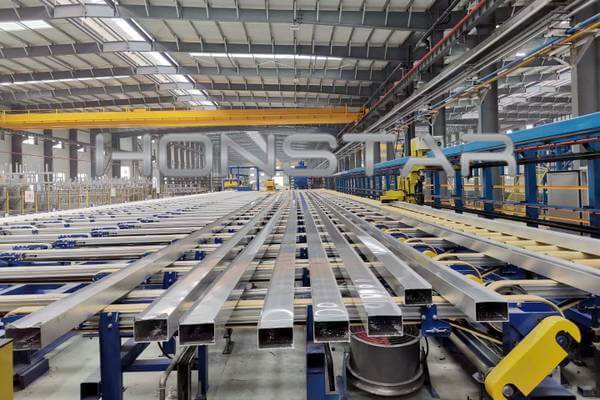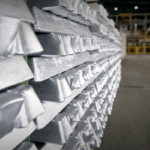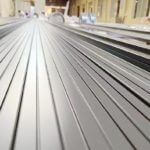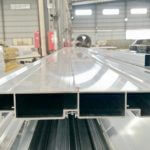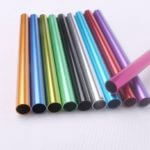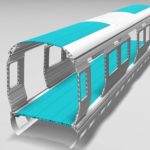7 Tips for Aluminum Profile Section Design
7 Tips for Aluminum Profile Section Design
Difficulty in extruding, low yield, and high cost often occur in aluminum extrusion production.
The common solution is to improve the process and related equipment.
Honstar Aluminum Products Co., Ltd proposes to solve some production problems and reduce the difficulty of mold design and manufacture by improving the design of aluminum sections in the design stage.
This article analyzes the section design of aluminum profiles, on the premise of satisfying the functionality, it introduces some commonly used skills in section design, which reduces the difficulty of aluminum production process and saves production costs.
The reason why aluminum profiles are widely used in life and production is due to the full recognition of their advantages such as low density, corrosion resistance, excellent electrical conductivity, non-ferromagnetic, good processing, and recyclable.
However, with the continuous improvement of the market’s requirements for aluminum profile products, the production of aluminum profiles is developing in the direction of complexity, high precision, and large size, which brings a series of production problems.
Most of the production of aluminum profiles adopts the extrusion method.
In addition to the performance of the extrusion press, the design of the mold, the composition of the aluminum billets, heat treatment and other process factors, the cross-sectional design of the profile should also be considered during production.
The optimal section design of aluminum profiles can not only reduce the difficulty of the process from the source but also improve the quality and use the effect of the product, reduce the cost and shorten the delivery time.
Through the actual case in production, Honstar Aluminum summarizes some commonly used skills in the design of aluminum profile section.
Principles of Sectional Design of Aluminum Profiles
Aluminum extrusion is a processing method that puts heated aluminum billets into an extrusion container, applies pressure through an extrusion press, and extrudes it from a die hole of a given shape and size to produce plastic deformation to obtain the required product.
Since the metal is affected by various factors such as the temperature of the aluminum billets, the extrusion speed, the amount of deformation, and the mold during the deformation process, it is difficult to control the uniformity of the metal outflow, which brings certain difficulties to the mold design.
In order to ensure the strength of the mold and avoid cracks, collapse, chipping, etc., in the section design of aluminum profile, try to avoid large cantilevers, small openings, small holes, multi-holes, asymmetrical, thin-walled, uneven wall thickness and other sections shape.
When designing, first of all, its performance such as use and decoration must be satisfied, and the cross-section obtained from this design is usable, but not the best solution.
Because when the designer lacks extrusion process knowledge and does not understand the relevant processing equipment, the production process requirements will be too high and too strict, resulting in reduced pass rate, increased cost, and even it cannot be produced by the existing production process.
Therefore, the principle of aluminum profile section design is: to complete it with the simplest process as possible under the premise of satisfying its functional design.
7 Tips for Aluminum Profile Section Design
- 1. Tolerance compensation
Closing is one of the common defects in aluminum extrusion production, and the main reasons are as follows:
Aluminum profiles with deep section openings tend to close up when extruded;
Stretching and straightening of aluminum profiles will aggravate the closing;
The thermal barrier injected aluminum profiles of some structures will also close up due to the shrinkage of the polymer polyurethane after it is injected.
If the above closing is not serious, the flow rate can be controlled by the mold design to avoid the closing.
But if several factors are superimposed and the mold design and related processes cannot solve the closing problem, pre-compensation can be given in the section design that is, pre-opening.
The amount of compensation to be opened should be selected according to its specific structure and past closing experience.
- 2. Separate big into small
With the development of large-size aluminum profiles, the cross-sectional design of many profiles is getting larger and larger, which means that a series of equipment such as a large extrusion press, large molds, and large aluminum billets are required to match them, and the production cost has risen sharply.
For some large-size sections that can be achieved by jointing, they should be separated into several small sections during design, which can not only reduce costs, but also ensure flatness, bend and accuracy.
- 3. Keep flatness and add reinforcement
The section of aluminum profile often meets the requirement of flatness during the design, and a small section of aluminum profile is easy to ensure flatness due to its good structural strength.
The big section aluminum profile will sag due to its own gravity just after extrusion, and the bending stress in the middle is the largest and the sag is the most serious.
It is also easy to generate waves due to the long wall part, which will deteriorate the plane intermittently.
Therefore, large-size flat plate structures should be avoided in section design, and reinforcing ribs can be provided in the middle part to improve its flatness if necessary.
- 4. Secondary processing
In aluminum profile production process, some sections are difficult to complete through the extrusion, and even if it can be processed, the production cost will be too high.
At this time, a secondary processing method can be considered.
Case 1: A hole with a diameter of less than 4mm on the section of aluminum profile will make the mold insufficient in strength, easily damaged, and difficult to process.
It is recommended to remove the small hole in the mold and use the drilling method after the extrusion instead.
- 5. Make exterior complicated and interior simple
The aluminum profile extrusion die can be divided into a solid die and a porthole die.
The processing of the solid die is relatively simple, and the porthole die involves relatively complicated processing of the cavity and core, therefore, it is also necessary to design the cross-section of aluminum profile.
It should be fully considered, that is, the exterior part of the section can be designed to be more complicated, and the grooves and screw holes should be placed on the periphery as much as possible, while the interior should be as simple as possible, and the accuracy requirements should not be too high.
In this way, both mold processing and maintenance will be much simpler, and the yield rate will also increase.
- 6. Reserve proper tolerance
Aluminum profiles have different surface treatment methods according to customer needs after extrusion.
Among them, the anodizing and electrophoresis methods have little effect on the wall thickness due to the thin film layer.
If the surface treatment method of powder coating is adopted, it is easy to accumulate powder in the corners and grooves, and its single layer thickness can reach 100μm, If this is an assembly position, which will lead to failure of assembly and affect the use.
In addition, as the number of aluminum extrusion processes increases and the mold wears out, the wall thickness of aluminum profile will become bigger and bigger and more difficult to assemble.
Based on the above reasons, it is necessary to reserve an appropriate tolerance according to the specific situation during design to ensure assembly.
- 7. Dimension tolerance mark
The section design first produces the assembly drawing and then the drawing of aluminum extrusion.
The correctness of the assembly drawing does not mean that aluminum profile extrusion drawing is perfect.
Some designers ignore the importance of dimension and tolerance marking.
The position of the dimension tolerance mark is generally the dimension that needs to be guaranteed, such as: assembly position, opening, groove depth, groove width, etc., and it is easy to measure and inspect.
For general dimensional tolerances, you can choose the corresponding precision level according to the national standard, and some important assembly dimensions need to indicate the specified tolerance value in the drawing.
If the tolerance is too large, the assembly will be difficult.
Honstar Aluminum Products Co., Ltd has been an aluminum industry leader for over 12 years in manufacturing precision aluminum parts, custom aluminum extrusions and standard aluminum extrusions.
We focus exclusively on producing the smallest, most complex, precision aluminum parts, custom aluminum extrusions, standard aluminum extrusions and floor covering aluminum profiles.
Contact us now for your aluminum profile order, and offer the total solution and one-stop service for your request.

